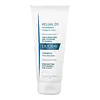What's inside
What's inside
 Key Ingredients
Key Ingredients

No key ingredients
 Benefits
Benefits

 Concerns
Concerns

 Ingredients Side-by-side
Ingredients Side-by-side

Water
Skin ConditioningLactamide Mea
HumectantSodium Cocoamphoacetate
CleansingCeteareth-60 Myristyl Glycol
EmulsifyingDecyl Glucoside
CleansingDisodium Cocoyl Glutamate
CleansingPolysorbate 20
EmulsifyingSodium Chloride
MaskingCitric Acid
BufferingGlycerin
HumectantAscorbyl Palmitate
AntioxidantCoco-Glucoside
CleansingGlyceryl Oleate
EmollientHydrogenated Palm Glycerides Citrate
EmollientLecithin
EmollientPEG-120 Methyl Glucose Dioleate
EmulsifyingPiroctone Olamine
PreservativePropylene Glycol
HumectantSodium Benzoate
MaskingTocopherol
AntioxidantTrisodium Ethylenediamine Disuccinate
Zinc Gluconate
Skin ConditioningWater, Lactamide Mea, Sodium Cocoamphoacetate, Ceteareth-60 Myristyl Glycol, Decyl Glucoside, Disodium Cocoyl Glutamate, Polysorbate 20, Sodium Chloride, Citric Acid, Glycerin, Ascorbyl Palmitate, Coco-Glucoside, Glyceryl Oleate, Hydrogenated Palm Glycerides Citrate, Lecithin, PEG-120 Methyl Glucose Dioleate, Piroctone Olamine, Propylene Glycol, Sodium Benzoate, Tocopherol, Trisodium Ethylenediamine Disuccinate, Zinc Gluconate
Water
Skin ConditioningGlycerin
HumectantCaprylic/Capric Triglyceride
MaskingButylene Glycol
HumectantPolysorbate 60
EmulsifyingGlyceryl Stearate
EmollientButyrospermum Parkii Butter
Skin ConditioningBeeswax
Emulsion StabilisingPEG-100 Stearate
10-Hydroxydecenoic Acid
Skin ConditioningCaprylyl Glycol
EmollientCetyl Alcohol
EmollientCitric Acid
BufferingGlycyrrhetinic Acid
Skin ConditioningPolyacrylate-13
Polyisobutene
Polysorbate 20
EmulsifyingSclerotium Gum
Emulsion StabilisingSorbitan Isostearate
EmulsifyingWater, Glycerin, Caprylic/Capric Triglyceride, Butylene Glycol, Polysorbate 60, Glyceryl Stearate, Butyrospermum Parkii Butter, Beeswax, PEG-100 Stearate, 10-Hydroxydecenoic Acid, Caprylyl Glycol, Cetyl Alcohol, Citric Acid, Glycyrrhetinic Acid, Polyacrylate-13, Polyisobutene, Polysorbate 20, Sclerotium Gum, Sorbitan Isostearate
Ingredients Explained
These ingredients are found in both products.
Ingredients higher up in an ingredient list are typically present in a larger amount.
Citric Acid is an alpha hydroxy acid (AHA) naturally found in citrus fruits like oranges, lemons, and limes.
Like other AHAs, citric acid can exfoliate skin by breaking down the bonds that hold dead skin cells together. This helps reveal smoother and brighter skin underneath.
However, this exfoliating effect only happens at high concentrations (20%) which can be hard to find in cosmetic products.
Due to this, citric acid is usually included in small amounts as a pH adjuster. This helps keep products slightly more acidic and compatible with skin's natural pH.
In skincare formulas, citric acid can:
While it can provide some skin benefits, research shows lactic acid and glycolic acid are generally more effective and less irritating exfoliants.
Most citric acid used in skincare today is made by fermenting sugars (usually from molasses). This synthetic version is identical to the natural citrus form but easier to stabilize and use in formulations.
Read more about some other popular AHA's here:
Learn more about Citric AcidGlycerin is already naturally found in your skin. It helps moisturize and protect your skin.
A study from 2016 found glycerin to be more effective as a humectant than AHAs and hyaluronic acid.
As a humectant, it helps the skin stay hydrated by pulling moisture to your skin. The low molecular weight of glycerin allows it to pull moisture into the deeper layers of your skin.
Hydrated skin improves your skin barrier; Your skin barrier helps protect against irritants and bacteria.
Glycerin has also been found to have antimicrobial and antiviral properties. Due to these properties, glycerin is often used in wound and burn treatments.
In cosmetics, glycerin is usually derived from plants such as soybean or palm. However, it can also be sourced from animals, such as tallow or animal fat.
This ingredient is organic, colorless, odorless, and non-toxic.
Glycerin is the name for this ingredient in American English. British English uses Glycerol/Glycerine.
Learn more about GlycerinPolysorbate 20 is made by combining ethoxylation of sorbitan, ethylene oxide, and lauric acid. It is a mild cleansing agent, surfactant, and emulsifier.
As a surfactant, it helps collect dirt and oils for washing. Emulsifiers prevent oils and water from separating.
Polysorbate 20 also adds scent to a product. Since it is made using sorbitol, it has a sweet scent. Sorbitol can also be found in fruits such as apples and peaches.
The lauric acid used to create Polysorbate 20 is often derived from coconuts.
Polysorbate 20 may not be fungal acne safe.
Learn more about Polysorbate 20Water. It's the most common cosmetic ingredient of all. You'll usually see it at the top of ingredient lists, meaning that it makes up the largest part of the product.
So why is it so popular? Water most often acts as a solvent - this means that it helps dissolve other ingredients into the formulation.
You'll also recognize water as that liquid we all need to stay alive. If you see this, drink a glass of water. Stay hydrated!
Learn more about Water